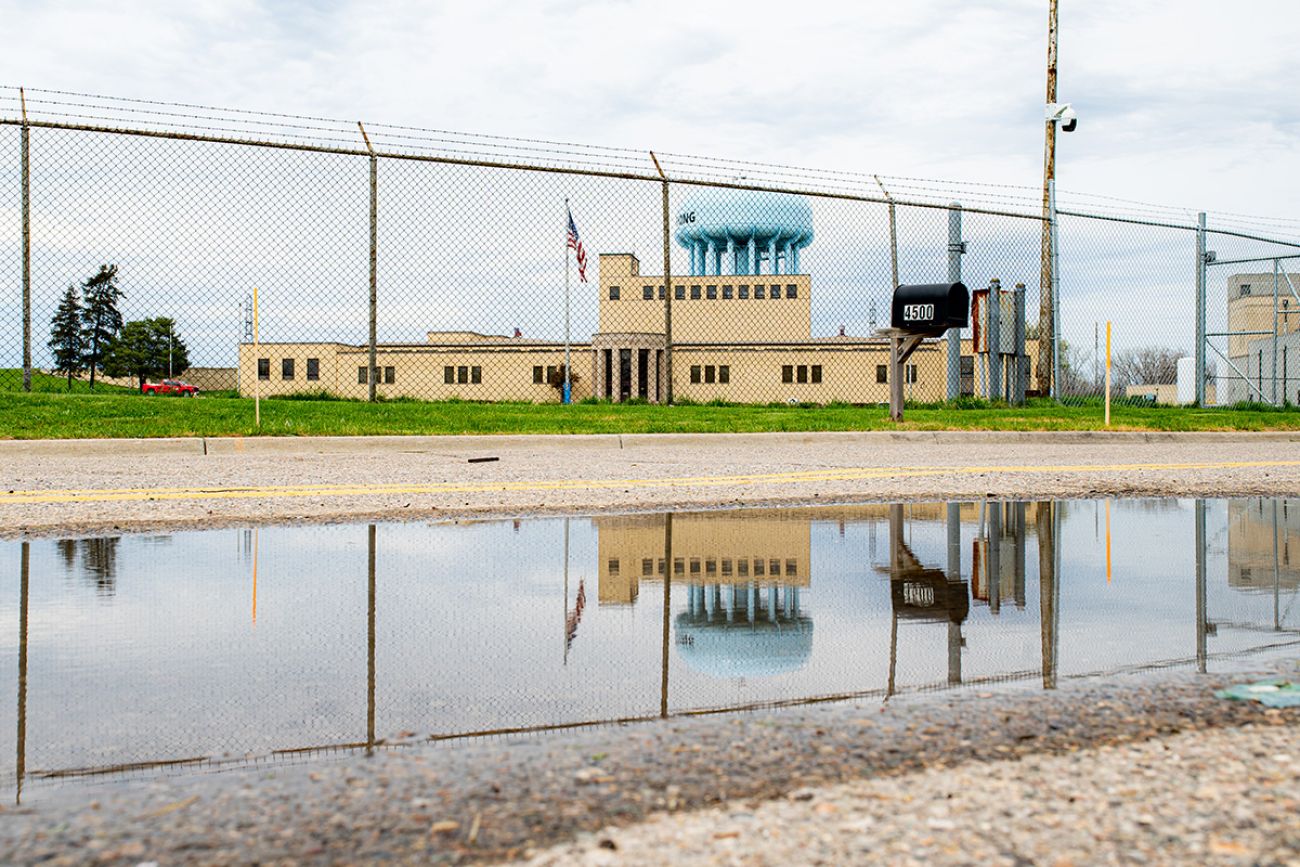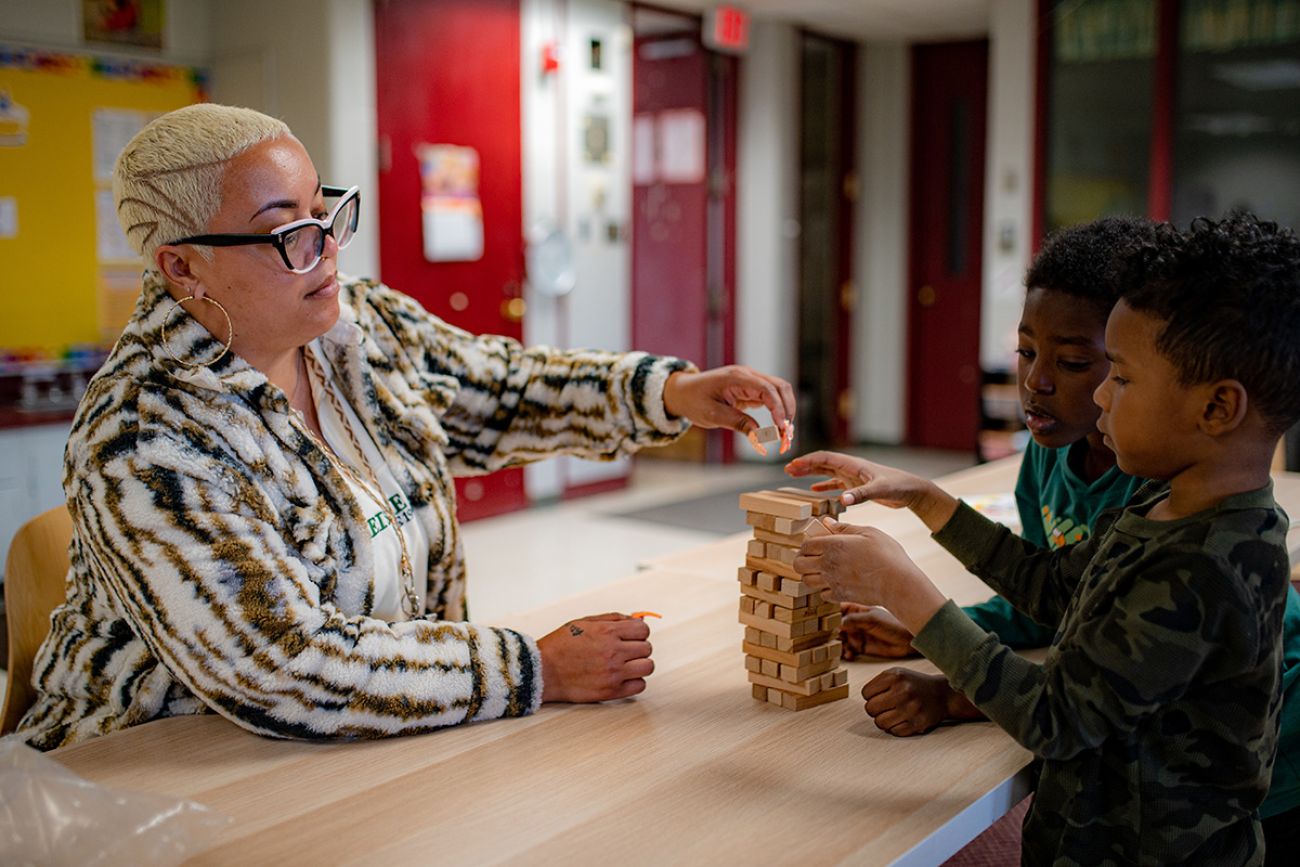Flint water crisis still crippling kids’ futures. But not because of lead

- On average, Flint students are learning less than before the city’s water crisis
- A growing body of research, though, suggests lead is not the cause for learning troubles
- That’s good news for children, suggesting the problems can be reversed with more support and better services
FLINT — The Flint water crisis caught up to Karen Christian’s classroom a few years ago, when children who were toddlers when the crisis began in 2014 entered sixth grade.
“I could usually keep my subjects going for about 30, 35 minutes, but not anymore,” said Christian, a veteran teacher at Potter Elementary in Flint. Now, “it's about 20 minutes and I have to change to something else. Otherwise, they get antsy.
“When the water crisis first happened, we didn't see so much (change) because we had a lot of the older kids who weren't affected as much,” she said. “But now as we've been getting the ones who were (ages) 1, 2, 3 (during the crisis) and born into it, those are the ones that we're seeing problems.”
In April 2014, an emergency manager appointed by the state to oversee Flint switched its water supply to the Flint River to save money. That set off a series of calamities that allowed lead to leach into the water supply of about 100,000 residents.
Most vulnerable: the city’s 6,200 children under the age of 6. Doctors and scientists warned they could suffer lifelong consequences, including lowered IQ and behavioral issues. A national lead expert said Flint’s children would suffer “some degree of brain damage.” The city’s mayor at the time suggested the need to expand the juvenile justice system.
A decade later, a plethora of research into Flint classrooms confirms that children of the crisis have significantly lower test scores on average, but suggests the lead that infiltrated their homes isn’t to blame. A University of Michigan study found no difference in academic outcomes between city youths with lead service lines to their homes and those without.
That’s good news for Flint children because it shows that few — if any — are cognitively impaired as some warned 10 years ago, and there is plenty of hope with the right services.
The problem, as years of accumulating evidence now makes clear, is a constellation of other problems, starting with the usual suspects of threadbare schools and grinding poverty to a far more insidious culprit: a decade of parents, doctors, community members and teachers sending the message to students that lead stole their capacity to learn.
The challenge now facing Flint is as daunting as replacing the city’s roughly 120 miles of lead pipes: convincing parents, teachers and community leaders to believe the latest findings, when a decade of heartbreak has taught them to distrust outsiders telling them everything is OK.

“We’re letting water health risks be exaggerated,” said Marc Edwards, a Virginia Tech researcher who helped expose the water crisis.
“Don’t label these kids. They can learn.”
Academic woes
There’s no doubt the Flint water crisis and the trauma it unleashed had a profound, negative impact on the city and its children.
U-M research found that children suffered significant academic setbacks after the crisis, falling five months behind in math from their learning rates before lead leached into the drinking supply. That study followed all Flint children, whether they were enrolled in the city’s traditional school district, surrounding districts or charter schools.
“There's no doubt that the Flint water crisis had a significant negative impact on educational outcomes,” said Brian Jacob, a co-author of the U-M report.
The kids in that study were the ones researchers expected to be least affected by lead-tainted water — they were school-age at the time of the crisis, and lead poisoning has the largest impact on infants to preschoolers.

A second study by the same authors following children who were 0-5 at the time of the crisis is expected to be released later this year. In the meantime, state data through the 2022-23 school year hints at more troubling trends.
- It’s taking students longer to graduate. The share of Flint Community Schools students who earn a diploma in four years of high school dropped from 59% in the 2014-15 school year, when the crisis began, to 35% in 2022-23. The state rate moved from 80% to 82% in that same time span, while Detroit Public Schools Community District’s rate was 74%.
- Fewer students are going to college. The share of Flint graduating seniors enrolling in college within six months of graduation dropped from 59% in 2014-15 to 25% in 2022-23. Detroit sent 43% of its grads to college in 2022-23, and the state average was 53%.
- Special-education rates are rising. The share of Flint students in special education was close to the state average at the beginning of the water crisis (15%, compared to 13% statewide). By 2022-23, 23% of Flint students were in special education, compared to 14% in the state.
Flint Superintendent Kevelin Jones told Bridge that “I’m not an expert” on the impact of lead, adding “we don’t narrow it (the reason for low academic achievement) to one or two things.”
One caveat to the state data about Flint Community Schools: Just 1 in 5 Flint children attend the city’s traditional school district, with the rest attending charter schools and nearby districts.
One adjacent district that takes in about 600 Flint students through school of choice is Kearsley Community Schools. Superintendent Paul Gaudard told Bridge he sees the same academic, behavioral and mental health challenges in his home district students who weren’t exposed to lead as he sees with students who travel to the district from Flint.
Still, teachers who spoke to Bridge Michigan said they have noticed a difference since the water crisis.
“What I don't think is fair is to declare children brain damaged. It's a myth” — Dr. Hernan Gomez
Bethany Nyswaner, a third-grade teacher at Potter Elementary in Flint, said her students are struggling to learn at the same pace as past classes. Some, she says, appear not to “have the capacity to learn. You can sit and work on something and then a few days later, it's not there. They're not retaining information” she said.
Three miles away from Potter Elementary, Sylvester Broome Empowerment Village provides after-school programs including classroom tutoring. About 200 Flint students from kindergarten through high school enroll in the center’s free programs, which include sports and music programs in addition to academic lessons.
Education Director Audrey Medlin said many children in Flint are “multiple years behind” in learning, a problem she says has gotten worse since the water crisis.
“If every time you enter an educational setting it feels so out of reach, wouldn't you give up before you even started?”

On a recent evening at the center, Elisha Mitchell stood at the front of a classroom of first- to third-graders working on reading and writing. It was a slow process.
“They know that they should know this stuff, but they just can't do it,” said Mitchell, who taught for 10 years and now works for the Michigan Child Protective Services.
“It’s heartbreaking as a teacher. How are we going to help these kids?”
A ray of hope
Most educators who spoke to Bridge blame the academic struggles of Flint children on lead. And some physicians, including one who testified in the lawsuit against the state that was settled for $626 million, said at least some children were brain damaged from lead poisoning.
But several studies suggest lead accounts for only some or none of the struggles of the city’s children.
The U-M study found students who lived in homes with lead water service lines or non-lead lines both saw similar learning declines, despite an estimate that those living in lead-service homes consumed 4.5 times more lead per day.
“That was by far the most surprising thing I’ve found in maybe 20 years of doing research,” said U-M researcher Jacob. “We had a strong prior hypothesis that kids who lived in houses with lead service lines would have likely had greater levels of lead contamination and that would have meant their academic performance would be worse. We didn't find that.”
The level of lead in the water, coupled with the facts that not all the city had lead in their water supply and that many families switched to bottled water early in the crisis because of the brown, malodorous liquid coming from their taps, led U-M researchers to believe “the effects of only lead to be smaller than the overall (academic) effects of the Flint Water Crisis,” according to the study.
That’s good news for Flint children: If predictions of irreversible brain damage didn’t materialize, then their scholastic struggles have the potential to be addressed.
Instead of being held back by lead, argue some experts and physicians, children are hobbled by lowered expectations.
Dr. Hernan Gomez, a pediatric emergency room physician at Hurley Medical Center in Flint and a certified toxicologist, shared with Bridge data that shows the increase in the percentage of children with elevated levels of lead in their blood during the water crisis was not high enough to lead to large declines in academic outcomes.
Agreeing with Gomez is Dr. Susan Buchanan, director of the Great Lakes Center for Children’s and Reproductive Environmental Health at the University of Illinois-Chicago. Buchanan, who treats patients with high exposure to lead, said it’s untrue that Flint children will be unable to learn in school.
Buchanan pointed to herself, who grew up in the 1970s when lead exposure was higher, as an example. “I probably lost some IQ points (because of lead), but I made it through medical school and am a practicing physician,” she said.
Dr. Mona Hanna-Attisha, a Flint pediatrician, was instrumental in exposing the water crisis when in 2015 she released data showing an alarming increase in children with elevated levels of lead in their blood.
She acknowledges it’s nearly impossible to tie lead exposure to any particular neurological outcome.
“There’s a long time lag from when you’ve been exposed to when you have a problem,” Hanna-Attisha told Bridge. “A problem that you have — say it’s a learning disability — often those problems are also caused by lots of other things too, (such as) poverty and poor nutrition and genetic stuff.
“So it's very difficult to say that all of these things are because of the water crisis or because of all these other toxicities in Flint that make it really hard for kids to be successful.”
Another factor is that learning loss is typical after a communitywide disaster. Following Hurricane Katrina in 2005, New Orleans children returned to classes an average of more than two years behind in learning. The difference in Flint: The community was told children may not be able to recover because of the irreversible effects of lead.
“The community has every right to be outraged,” Gomez said. “(But) what I don't think is fair is to declare children brain-damaged. It's a myth, and it's not plausible.”
That’s not the view among many in the community. Christian, the sixth-grade teacher, saw an example of that last year. “I had a student who was being raised by her grandmother, and when we were doing certain things in class, (the student) would constantly say to me, ‘I can't do this,’” Christian said. “And every time the grandmother would come in, and she (the grandmother) would immediately tell me, ‘She can't do any of this because of the lead, and I have a doctor's note.’
“There are some children who just believe it because parents and grandparents are talking about it,” Christian said. “But not all of them.”
“The health crisis will not be a crutch for my children” — Ashley Strozier
Several studies found that teachers’ expectations about their students and parents' academic expectations about their own children — whether those expectations are high or low — have a major impact on student performance.
“If I’m told I can’t do something, then I approach everything from the perspective of ‘I can’t do it,’” said Elizabeth Moje, dean of the Marsal Family School of Education at the University of Michigan. “My motivation is going to decline. Nobody likes to do badly.
“And if I’m advised by teachers or parents (who have low expectations), ‘Don’t try this, it’s going to be too hard,’ I’m going to miss out on opportunities.”
Changing expectations is a big lift in Flint, where residents have been told for years that lead exposure during the water crisis could impact children’s ability to learn.
Christian, the sixth grade teacher, recalls a presentation made by the Michigan Education Association to Flint teachers a year or two after the water crisis, in which Karen Binns, a professor of pediatrics and preventative medicine at Northwestern University in Chicago, suggested that lead levels from the crisis were not high enough to cause brain damage and that teachers should assume all the children can learn at a normal level.
“That didn’t go over well” among educators who were living and working in Flint, Christian said.
“There's not a high expectation for us to succeed in the classroom,” said Cruz Duhart, a Flint native who recently graduated from Morehouse College in Atlanta. “There might be something to why that could come about (from) the water crisis.”
Edwards, the Virginia Tech researcher who was instrumental in exposing Flint’s lead crisis, said he feels “horrible” for the families who have suffered, and “government should not fail at all levels and the initial betrayal should never have occurred.”
But Flint has a chance to help its children by acknowledging that not all of their problems are tied to the neurotoxin, and developing support systems that can help them overcome the negative narrative that shadows them.
“You have this amazing narrative, and no one wants to let it go,” Edwards said. “It’s so ingrained that no one wants to hear alternative explanations or consider the harm that we might be doing to these kids.”
There are many reasons for Flint children to struggle in school beyond lead exposure. By one measure, Flint is the poorest city in America of over 65,000 people, with 1 in 3 residents living below the federal poverty line.
On average, academic achievement is lower among low-income students.
The pandemic could also play a role. Academic achievement statewide was hurt by the pandemic and the months many students were out of classrooms, but the biggest declines in learning were in low-income urban communities like Flint.
The isolation of the pandemic also had an impact on behavioral health, particularly among young elementary students, for whom school plays an integral role in socialization.
“There are so many aspects beyond lead that influence learning in Flint,” said Melodie Marsh, who grew up in Flint during the crisis and is now a freshman at Howard University in Washington, D.C. “Like adequate access to healthy food — Flint has food deserts. Or not having breakfast or dinner the night before.”
Decades of work to go
There have been massive efforts to help Flint children and their families since the crisis: At least $575 million has come from foundations and the state and federal government, while another $626 million is coming in the next few months from a lawsuit settlement against the state of Michigan.
Today there are filtered water hydration stations and fresh food giveaways in schools, and “nutrition prescriptions” for free fruits and vegetables at the Flint Farmers’ Market. There are literacy programs and new preschool centers, playgrounds and home nurse visiting support.
None of the efforts are focused solely on lead, but instead target the burdens faced by all children in Flint.
“We’ve always framed all our work as addressing trauma,” said pediatrician Hanna-Attisha. “We're going to need more than bottled water,” she added. “We're going to need to figure out how to support kids and families for at least the next couple of decades.”
“When I'm holding a little baby in my hand, and that wide-eyed baby is literally staring at me, it’s like they’re saying, ‘Do better.’
‘The crisis will not be a crutch’
If Flint is looking for an example of the power of positive expectations, it can look to the children of Ashley Strozier.
Clarence and Clarissa Ruffin were 5 and 3, respectively, in 2014 when the water coming out of faucets in their north Flint home turned brown, making them prime candidates for health, behavioral and academic problems.
Before the water crisis, “they were both healthy,” said Strozier, their mother.

Afterward, Clarissa contracted what her family believes was Legionnaire’s disease from bacteria in the improperly treated river water, was hospitalized and lost part of one lung. Clarence developed asthma, which he continues to deal with 10 years later. Both were found to have lead in their blood, though at a rate below the 5 micrograms per deciliter considered by the Centers for Disease Control to be the bar for concern.
Strozier heard all the warnings about how the neurotoxin that had leached into the water supply would hobble her children’s ability to learn. And while she knows plenty of families whose kids are struggling in school, Clarence and Clarissa are doing well.
Now in sixth grade, Clarissa is an A student, a cheerleader, and wants to someday perform on Broadway. Clarence plays tuba and likes science.
“With education professionals in my family, books were always important when I had my own children,” Strozier said. “I was very intentional about how we spent our time, at libraries and museums.”
Strozier points to one big difference that helped her kids succeed: She never doubted her children could do well in school.
“The health crisis will not be a crutch for my children,” she said. “I know a lot of people have struggled, … (but) going through the crisis has taught me not to take information at face value.”
Michigan Education Watch
Michigan Education Watch is made possible by generous financial support from:
Subscribe to Michigan Health Watch
See what new members are saying about why they donated to Bridge Michigan:
- “In order for this information to be accurate and unbiased it must be underwritten by its readers, not by special interests.” - Larry S.
- “Not many other media sources report on the topics Bridge does.” - Susan B.
- “Your journalism is outstanding and rare these days.” - Mark S.
If you want to ensure the future of nonpartisan, nonprofit Michigan journalism, please become a member today. You, too, will be asked why you donated and maybe we'll feature your quote next time!





